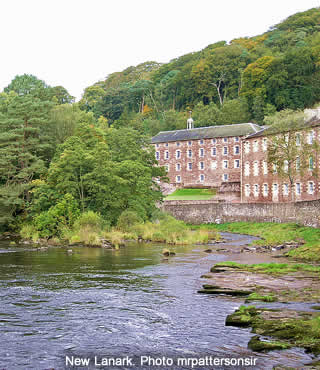New Lanark |
|
 |
|||
Technological and philanthropic revolutions, in the same place |
||||
|
||||
For years, painters had called the Clyde River's waterfalls beautiful - but when David Dale, a merchant, and Richard Arkwright, an inventor, came along, all they saw was a source of energy. Together, they founded the village of New Lanark, which used this natural resource to power cotton mills on a scale Scotland had never seen. Soon, the settlement had grown to house 2500 people. |
||||
This was around the turn of the 19th century, when employees at such mills weren't generally treated with much care. Children were usually illiterate, and made to work from a very young age. In other parts of Britain this continued for years, but New Lanark was different - thanks to a man called Robert Owen. He married David Dale's daughter, and took over management of the mills. His sweeping changes included education for every child, and a ban on work before the age of ten. He set up religious meeting places, social events and comfortable housing for all. Owen took care of the village until 1825, when he left for America, to continue his philanthropy in the romantically-named town of New Harmony. The mills continued to operate until 1968, nearly two centuries after they were opened. |
||||
After their closure, some thought the buildings would slowly disappear. Instead they were looked after, and opened to the public. In 2001, the restoration work earned New Lanark official World Heritage status. |
||||
The first calling point is the Visitor Centre. There's a scale model of the valley, and explanations of how the mill engines worked. Along from here is a ride called the Millennium Experience. You're taken back to New Lanark's past, by girl from the year 2200. She then breaks the rules of time travel by letting you have a peek at the future. You're given an even more unlikely guide at the Annie McLeod Experience; she's the ghost of an 1820s mill worker, who explains what her life was like. |
||||
Inside Mill number 3, you can get a first hand view of the tasks, machines and tremendous noise that were part of every employee's day-to-day life. The main display is a fully-functioning cotton spinning machine. It's obvious how revolutionary this huge, complex piece of equipment must have been, at a time when the same jobs were still often done by hand. |
||||
The surrounding buildings have more attractions. Next door, in Mill number 2, is one of the largest Edinburgh Woollen Mill shops in Scotland. Across the road is Robert Owen's house, which still looks as it would have done in the early 1800s. It's not the only part of the village with an authentic appearance. Actually, there are strict rules in place. Residents can't use television aerials or satellites, and external woodwork follows a consistent pattern. |
||||
Just past the village is the Falls of Clyde National Park. The region takes its name from the four waterfalls on the River Clyde that lie in close proximity to each other. The tallest is Corra Lynn, at 27 metres. The water's flow is sometimes limited by the hydro-electric power stations along the river, but they shut down on pre-arranged "waterfall days", so people can see them at their best. |
||||
The park is home to badgers, deer and over a hundred species of bird. It's best explored via the Clyde Walkway, a footpath that runs from here, through New Lanark, and all the way on to Glasgow. |
||||
Of course, this is quite a strenuous way to arrive, so most prefer to travel via the bus or train stations at the nearby town of Lanark. The walk from there is only a mile or so, and happily, it's all downhill. |
||||
|
Pocket Britain is optimised for use on a smartphone or tablet with internet access. All content is subject to copyright. All reasonable methods have been used to ensure information supplied is accurate at the time of publication. However, it is advisable to check information before relying on it. Privacy Policy |